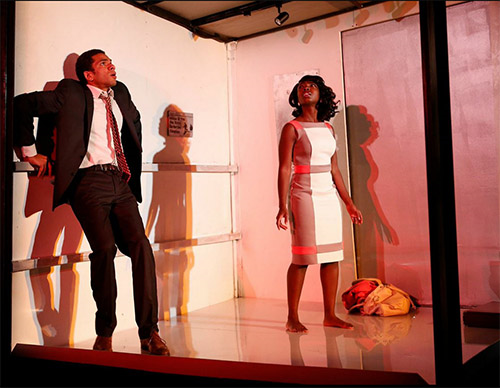Two days into rehearsals for Lift at 59E59, director John Marshall III got stuck in an elevator. Most people entombed in a metal box might feel alarmed, claustrophobic, or at the very least, concerned. Instead, Marshall was thrilled. "I think the people running the building probably thought I was crazy," he says. "I'm like, 'Don't hurry, it's ok! It's great!'"
See, Lift is a full-length play by Walter Mosley in which a man and a woman are trapped in a broken elevator. This means two actors are confined to the same square of space for almost two hours: a challenge for any theatre director. "The elevator was essentially a third character in the play," says Marshall, who last year mounted a production of the show at New Jersey's Crossroads Theatre, where he serves as artistic director. Unable to rehearse on the set during its construction, actors stood on platforms and cubes, using any and every opportunity to simulate the feeling of entrapment. That's why Marshall was so excited to have firsthand experience. "I was texting the actors," he says of his elevator mishap. "I was on the bottom floor, and it wasn't rocking. I don't know if my confidence would've been quite the same if I had been twenty floors up in the air. But I was really having fun."
Tina and Southmore, two New Yorkers who happen to be sharing a ride when their building is blasted by an unspecified terrorist attack, are actually stuck <em>more</em> than twenty floors up. The terrified occupants get to know each other with the instant intimacy of people who are liable to fall to their deaths at any moment. Mosley, best known as the author of the Easy Rawlins mystery novels, provides his characters with specific and steadily unfurling backstories, which Marshall realized gives each revelation significant weight in such a restricted setting.
"Even though it's a play, I think Walter had a perspective of the cinema," he explains. "A lot of the play's moments felt like closeups: he touches her chin with his hand, a lot of things like that. What we tried to do was reinterpret those stage directions in the context of this full environment
Each "closeup" in each beat of the story reverberates more clearly when the action is enclosed in a six-by-six square. So when it comes to the big picture, the actors' every move must be carefully calibrated to advance the plot without the benefit of entrances and exits---and keep the audience's attention focused on every physical, emotional, and tonal shift in Tina and Southmore's evolving relationship. As Marshall says, "This is a two year courtship compressed into two hours."
Another way to avoid inertia onstage is to break up the action into manageable chunks. Marshall gives both actors and audiences breathing room by inserting musical interludes between Mosley's separated scenes. To provide continuity within the production's pauses, he uses an eclectic variety of songs from jazz musician Regina Carter. In the script, he says, "there's no mention of music. But I heard strings."
<em>Lift</em> is fueled by the belief that anybody could enter an elevator with a Tina or a Southmore; it happens every day in a big city. What makes this play resonate, particularly in the confines of a theatre, is the idea that we orbit around each other, immune to the gravitational pulls of all our tiny similarities. "The beauty of theatre is we realize that as a people we have much much more in common than we don't," says Marshall. Although we're too busy rushing through our routines to notice, the same can probably be said about those strangers in our elevator.
---
Jack Smart is a Brooklyn-based arts journalist and critic, and a staff writer at Back Stage. He blogs about theatre and pop culture at JackSmartReviews.
Photo by Carol Rosegg
